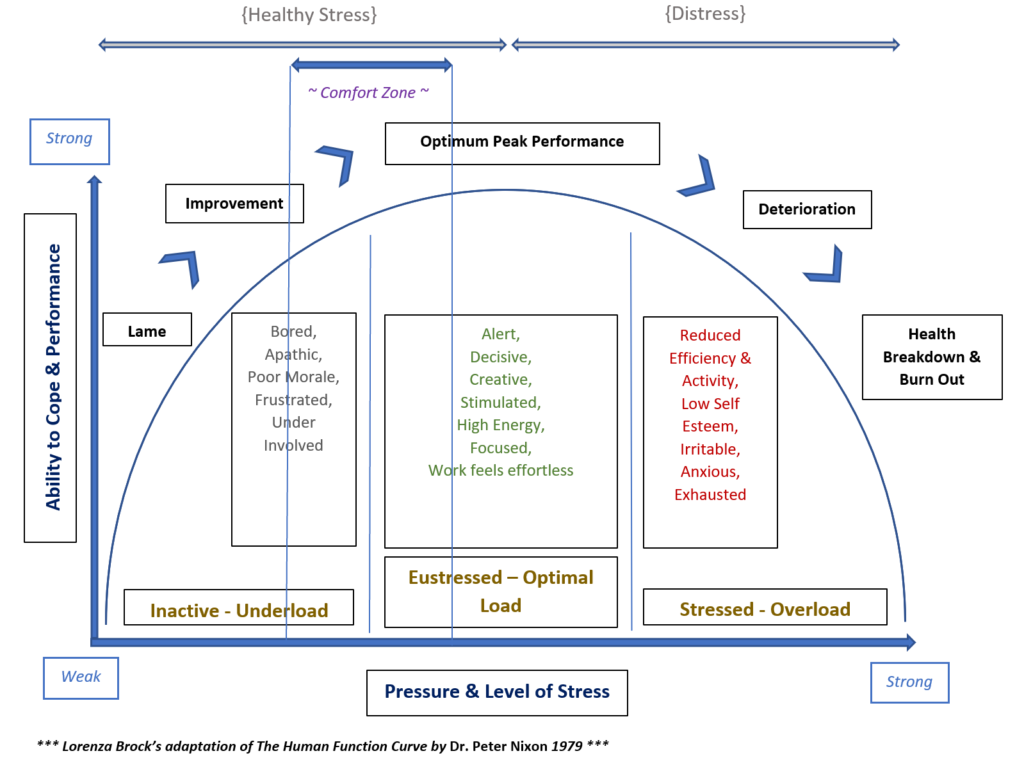In 1979, British cardiologist Dr. Peter Nixon developed a diagram to illustrate the balance of good and bad stress, which was later called the Human Function Curve.
Dr. Nixon used this graph to show his patients the stages of health: from a bored and inactive stage, to a healthy tension level and eventually to feeling exhausted, ill and burned out. He found that high levels of pressure and stress caused psychological deterioration as well as physical illness and believed that people could learn from their personal experiences how to live a balanced and successful life by using their mental, physical and spiritual energies in a wiser way.

You’ll probably find some of these stages quite familiar. First on the scale to the left is the lame, inactive, unfulfilled and frustrated stage followed by the comfort zone stage and the healthy stress stage characterized by the feeling of being stimulated, full of energy and focused. It is however once we cross over to the other side of the spectrum that we find ourselves feeling anxious and irritable. It is in this stage of low self-esteem that we start to make mistakes and eventually we get ourselves physically and mentally ill and eventually reaching burn out point.
This diagram is an excellent illustration of the different stages of pressure and stress and how they link to one another. Most importantly, it’s a useful tool to help us read and understand the alarm bells and preceding signs that can lead to illness as well as us help us manage our feelings and expectations.
Healthy Stress vs Distress

We all experience a certain level of stress every day. To experience stress is basically normal and part of life. Stress, or the level of stress, is generally a good indicator of where we are on the “Human Function Curve” and, as we have seen, there’s two types of “stress”:
- healthy stress
- distress
Healthy stress, also known as short-term stress, is beneficial to our health. It’s what gives us the determination and focus to do things and achieve goals, which are very important for good mental health and personal growth. Some examples are staring a new job, giving a presentation, passing an exam, going out with new friends and buying a house. Once healthy stress passes people normally feel relieved and even a little euphoric.
Distress, or unhealthy stress, is long-term and a state of mental or emotional strain or tension resulting from adverse or very difficult and demanding circumstances.
The level of stress we can handle and how we experience it differs from person to person. What one might find stressful, another might find challenging and even rewarding. How long one can hold the pressure also varies from subject to subject and this is why it is so important NOT to obsess over comparing ourselves to others! Beating ourselves up won’t help. But what does help is to understand our weaknesses and strengths and learn from experience.
The first step is to understand what the alarm bells are. Do I feel anxious? Do I feel irritable, exhausted, overloaded and am I dealing with too much pressure? If so, perhaps it’s time to stop and reflect. Taking a break to reassess what we are trying to achieve may be the best course of action and it may include having to think of a different route.
Beware of the comfort zone!

What about the middle of the road “comfort zone”? Comfort zones are comfortable and that’s why it’s so difficult to move away from them. However, they are also unchallenging and in the long term they leave us with a feeling of flatness and lack of motivation.
From time to time, it is good practice to challenge ourselves both physically and mentally. It helps us expand our mind, triggers creativity, expands our horizons, helps us identify our goals, our beliefs and our priorities and it can motivate us to get rid of boredom and unhappiness. Also, with every unsuccessful change we learn something new and with that we get a sense of contentment and gratification.
The strains of Distress on body and mind

It is well-established knowledge that when we are under stress our body is no longer able to maintain the high levels of pressure caused by the release of neurochemicals and hormones and our performance falls. More worryingly, the side effects on our body and mind can be very damaging. As distress, or long-term stress, gets a grip on us and settles in for the long run, we start to experience feelings of exhaustion and, as our mind descends into low self-esteem, our body’s immune system also takes a turn for the worse and illnesses and diseases begin to manifest.
COMMON EFFECTS OF STRESS ON THE BODY MAY INCLUDE:
- Headache
- General malaise or weakness
- Fatigue
- Sleep problems
- Recurrent colds and infections
- Aches, pains, and tense muscles
- Change in sex drive
- Gastritis and heartburn
- Unexplained symptoms
- Worsening of existing conditions
- Cardiovascular disorders, chest pain and rapid heartbeat
- Angina
COMMON EFFECTS OF STRESS ON THE MIND, MOOD AND BEHAVIOURS MAY INCLUDE:
- Poor mood, sadness, depression and unexplained feelings of despair
- Excessive anxiety
- Insomnia
- Restlessness
- Lack of motivation or focus
- Feeling overwhelmed
- Irritability or anger
- Angry outbursts
- Drug, alcohol or tobacco abuse
- Social withdrawal
Living in a constant state of stress takes its toll on our physical and mental health. Too much stress can cause devastating and fatal effects on our physical health: for example, under lots of stress gastritis could turn into internal bleeding and angina, which occurs when the heart works harder due to exertion or mental or emotional stress, can lead to a heart attack. Our mind also can break down: paranoia, overwhelming fear and various mental illnesses can take hold of our mind.
The body simply cannot cope long-term with the huge levels of adrenaline, cortisone and elevated hormone levels that stress can generate. It can cause arteries to become clogged, muscles to melt away and cause atrophy, nerves to become slow, bones to become brittle, vision to become blurred and hearing deafen.
How to de-stress

- LIFE EVENT STRESS AS A PREDICTION OF ILLNESS
There is a strong correlation between stressful events and illnesses. In 1967 psychiatrists Thomas Holmes and Richard Rahe examined the medical records of over 5,000 medical patients as part of their study to understand the correlation between stressful events and illnesses. Together they compiled the Holmes and Rahe stress scale: a list of 43 stressful life events that can contribute to illness.
They discovered that certain life events are more likely to lead to stress, for example the death of a loved one, getting divorced, losing a job and having financial difficulties are among the top ten causes of stress, but even some positive life changes, such as moving home, going on holiday or getting married can be sources of stress.
Stress can make us experience feelings of anxiety, fear, sadness, anger or frustration which can produce actual physical symptoms, for example headaches, nausea and indigestion, and it has even been linked to Irritable Bowel Syndrome (IBS), or stomach ulcers as well as conditions like cardiovascular disease. Finally, it can massively affect our behaviors, for example we may become withdrawn, indecisive, irritable and tearful and in some people, stress can lead to aggression, have an impact of their intake of alcohol, smoking habits and even affect sleeping patterns. Stress can even contribute to symptoms of depression.
Click here to learn how to prevent stress and illness by preparing ahead of potentially stressful events.
- SACRIFICING AND DENYING YOUR OWN NEEDS
Stress life events are not the only factor in contributing to illness. Sometimes we inflict stress on ourselves by actively sacrificing and denying our own needs to please others and, in so doing, essentially treating ourselves as less important than other people, feeling guilty for prioritizing our necessities and as if we have no control over our own life and choices.
Click here to find out how to identify and deal with subjugation lifetraps.
- WORK: HONEYMOON TO BURNOUT
For many, work is source of unhappiness and stress. Of course, some of us are lucky enough to say that they love their jobs and feel fulfilled at work, but for the majority of people and for most people at times in their lives, work is simply boring, repetitive and does not bring so much joy or fulfilment.
Click here to find out how work’s initial honeymoon can lead to burnout.
- THE POWER OF YOUR THOUGHTS
Our thoughts influence the way we feel and experience life events. Negative and unhelpful thoughts are responsible for causing anxiety and stress. When negative thinking takes residence within our minds for too long, it creates familiar habits that shape our mood, temperament and personality trait. In the short-term they can be managed, but in the long-term they become toxic and can cause mental and/or physical illness.
However, as Dr. Joe Dispenza explains, if it’s true that thoughts have such an influence on our well-being, then is it also true that our thoughts can make us well. This is why, from time to time, it’s important to re-evaluate our behaviours and habits, which are often linked to our memories and past experiences, and challenge their existence within ourselves, just the same way as we do with core beliefs.
Click here to learn how to live in the moment, keep a positive frame of mind and attitude, and create a positive narrative of your life.
- THE FINE ART OF BEING HAPPY
According to the 2019 Happiness Report, Finland is the happiest country in the world, with Denmark, Norway, Iceland and The Netherlands holding the next top positions. What we learn from the Nordic countries is that from a societal point of view we need to look at building a well-functioning infostructure where people can feel supported, valued and taken care of.
As individuals, though, we also have a duty to ourselves to actively try to be happy. Happiness is not something we stumble across and keep forever. It requires a constant effort of positivity and willingness. Miek Wiking, founder of the Happiness Research Institute, explains that we can and should be the architects of our own memories. Memories are not random. We have the power within ourselves to build a bank of happy memories.
Click here to read more on the fine art of being happy.
- THE BENEFITS OF EXERCISE
Evidence shows that being physically active through regular exercise helps preventing or managing a variety of health problems and concerns, such as high blood pressure, stroke, metabolic syndrome, type 2 diabetes, many types of cancer, arthritis as well as depression and anxiety. Physical exercise is especially important in childhood and young adulthood as regular exercise has been proven to help against a range of medical conditions and diseases. The benefits are huge and they are both physical as well as mental.
Whether you walk to work, train for a specific sport, opt for a mix of exercise classes or simply take up dancing in your own sitting room, as long as you follow the guideline of 150 minutes of activity per week (30 minutes a day 5 times a week), inevitably you will improve your health in more than one way!
Click here to find out more on the benefits of exercising.



